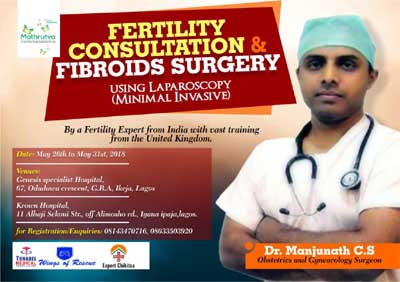Date: 26th to 31st of May, 2018
Venue: Genesis hospital
67, Oduduwa crescent, G.R.A, Ikeja, Lagos
Known hospital
11, Alhaji Sekoni street, off Alimosho rd, Iyana-ipaja, Lagos.
For further information call: 08143470716 or +2348033503920
Or
Url link
Registration must be done Two (2) weeks to this event.
Laparoscopic surgery is usually performed as out-patient surgery under general anesthesia and has absolutely revolutionized gynecologic surgery because of the short hospital stay and quick recovery. The laparoscope is a slender telescope that is inserted through the navel to view the pelvic and abdominal organs. Two or three small, half-inch incisions are made below the pubic hairline and instruments are passed through these small incisions to perform the surgery. Because the incisions are smaller, patients can enjoy faster recovery times and smaller scars.

Laparoscopic surgery differs from traditional surgery in a few key ways: during laparoscopic surgery, the surgeon is not looking into the abdomen directly through a large incision across the abdomen, but performs the surgery while looking at a large video monitor suspended over the patient’s abdomen. The surgery, and especially the suturing of the uterus that is necessary during a laparoscopic myomectomy, requires a great deal of hand-eye coordination and dexterity, as well as knowledge of pelvic anatomy in order to be successful.
The procedure is very safe an effective when performed by a properly trained physician and the technique continues to evolve as new instruments are developed. However, many physicians today still lack the skills necessary to perform myomectomies through the laparoscope and therefore do not offer them to patients. Because of the small size of the incisions and the level of skill needed to correctly perform the surgery, this procedure is actually harder for a physician to perform without the proper experience and takes more skill and training than abdominal surgery.
Advantages of laparoscopic myomectomy
• Small incisions and less scarring
• Gentler handling of the body tissues and organs during the operation
• Less postoperative pain
• Less postoperative narcotic use for pain relief
• Shorter hospitalisation
• Faster overall recovery with an earlier return to normal activity
How does laparoscopic myomectomy work?
Preoperative preparation involves a shave and a small enema, and you will need to fast for six hours before the operation.
• A general anaesthetic is administered.
• The laparoscope and other instruments are introduced,
• The fibroid is visualised. A cut is made in the uterus and the fibroid is freed from the uterine muscle.
• The incision in the uterus is repaired with sutures.
• The fibroid is removed, usually by cutting it up into small pieces to get it out of the small incisions.
• The wounds are closed.
Recovery after fibroid removal
Immediate post-operative recovery involves an average of two days in hospital. A fifth of patients can go home late the next day after surgery, and about 80% patients are home in two days. Patients are welcome to rest in hospital for as long as they need to.
One in five patients will only need tablets and not injections for postoperative pain relief. If injections are required about two are needed on average. Patients will be given as much pain relief as they request to make sure they are comfortable.
A low-grade temperature is common in the first few days after surgery. The first few days at home should be taken very easily. The patient should have someone to help. Plenty of rest and fluids are advisable. Exercise your calf muscles to prevent clots. Oral pain relief such as Panadeine or Panadol may be needed, especially at night.
Graded recovery over the next few weeks will occur. Gentle increasing exercise is helpful. Driving is permissible. Expect to tire easily. Bowel discomfort and some cramps are common. Return to normal activity occurs at about 2-3 weeks for many patients. All patients should individually assess their recovery rate. Some may need more time off work than others and certificates will always be provided. It is important not to have sexual intercourse for six weeks after the operation.
Dara Mould | Managing Director
Cell: +234 (0) 803 358 5428
Whatsapp: +234 (0) 803 358 5428
Email:dara.mould@wingsofrescue
Website: www.wingsofrescue.net
Integrity, Safety, Excellence and quality Care for human life (ISEC).
The post Fertility consultation and Fibriods surgery using laparoscopy (minimal invasive) by a fertility expert from India with vast training from the UK. appeared first on Vanguard News.
source https://www.vanguardngr.com/2018/04/fertility-consultation-fibriods-surgery-using-laparoscopy-minimal-invasive-fertility-expert-india-vast-training-uk/
Post A Comment:
0 comments so far,add yours